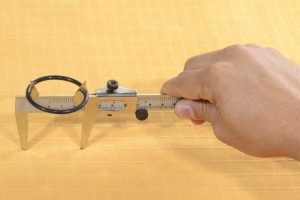How Do I Measure O Rings?
Oct 31, 2018
 In mechanical engineering, o-rings are a staple of a safe, functional assembly. In environments where high pressures or temperature extremes are common, they are the simplest and most effective way to create a reliable seal. Understanding how o rings are measured is a key skill for anyone who is responsible for the purchase or reordering of replacement gaskets for their facility.
In mechanical engineering, o-rings are a staple of a safe, functional assembly. In environments where high pressures or temperature extremes are common, they are the simplest and most effective way to create a reliable seal. Understanding how o rings are measured is a key skill for anyone who is responsible for the purchase or reordering of replacement gaskets for their facility.
You may have an o ring measuring tool or o-ring measuring gauge about your business, which is great. However, you still need to acquire the knowledge of how are o rings measured in order to accurately use these tools. Here’s what you need to know about getting the measurements of your o-ring right first time, every time.
Why do o-rings require accurate sizing?
Our o-rings are often used in sensitive environments, where pressures are extremely high or low, where temperatures are very high or low, or where chemicals or other dangerous liquids are in use. Failing to measure an o-ring correctly could result in a poor seal being made, risking failure and leaks within the system.
If you’re assembling an apparatus or machine for the first time, having the correct size and material of o-ring is crucial. Over time, your o-ring may start to wear or degrade, requiring replacement which, again, means knowing how are o rings measured in order to obtain the correct part. Having a poor fitting o-ring will decrease the lifespan of your seal and risks it failing unexpectedly.
How are o rings measured?
Here in the UK, o-rings are manufactured to specific sizes as specified by a British Standard (BS). Many rings will have a related BS number, which relates to the inside diameter, outside diameter and the thickness of the ring. These measurements can be taken in either inches or millimetres, although inches are the more common method used by o ring measuring tool products.
To measure your o-ring, follow these simple steps:
- Using a ruler, measure the distance between the outer edges, which will give you the outside diameter (OD)
- Using the ruler again, measure the distance across the inside of the ring, which will give you the inside diameter (ID)
- If you have a Vernier calliper, you can use this to measure the thickness of your o-ring. Place the gasket between the jaws of the calliper to take this measurement, but be careful not to compress the material at all otherwise you’ll get an inaccurate result
If the o-ring has been cut or damaged, or is not a solid ring, you can calculate the inside diameter using the thickness of the cross section (CS) measurement and the length (L) of the ring as follows:
- ID = circumference – CS
- Circumference = L / 3.142
- OD = ID + 2CS
Using these formulae, you should be able to find all the measurements you require in order to procure the correct replacement o-ring for your needs.
Using an o ring measuring tool
There are a number of tools out there to help you measure an o ring correctly. The two main types are the o-ring measuring gauge and the cone type o ring measuring tool. Here’s how to use them:
- The o-ring measuring gauge
This is a sliding tool with silhouettes of o-rings down its length. For smaller o-ring sizes, you simply match them up to one of the silhouettes on the body of the gauge. For o-rings of larger sizes, you can simply place them around the spindles at the top of the gauge and then extend the slider until the ring is taut. These measuring gauges can be found in both BS and AS (American Standard) configurations, and with both metric and imperial scales.
- The o-ring cone
These measuring cones have two measuring functions which aim to determine the thickness (CS) and the internal diameter. Around the bottom of the cone, slots will help you determine the CS of your o-ring by checking which one it fits in best. Once you’ve done that, you place the o-ring on the cone and see where it settles to determine the size.
Both of these products are relatively expensive for what they do and are probably an unnecessary investment unless you’re in the habit of measuring o-rings regularly. A Vernier calliper can be bought for a fraction of the cost and is useful in other elements of mechanical engineering too, for example when measuring the thickness of sheet metal, or the finer details of products.
If you are still not confident as to how an o-ring is measured, we’re here to help. You are welcome to send in your o-ring for measurement by our experts, or to contact us for help and advice on any of our products and their specifications. Getting the size of your o-ring right is crucially important, so don’t leave it to chance.
NES suggest that only o rings that have not being fitted into application are measured this way due to compressive force, temperature and groove dimensions. For further help on measuring o rings, please contact our technical team today.
